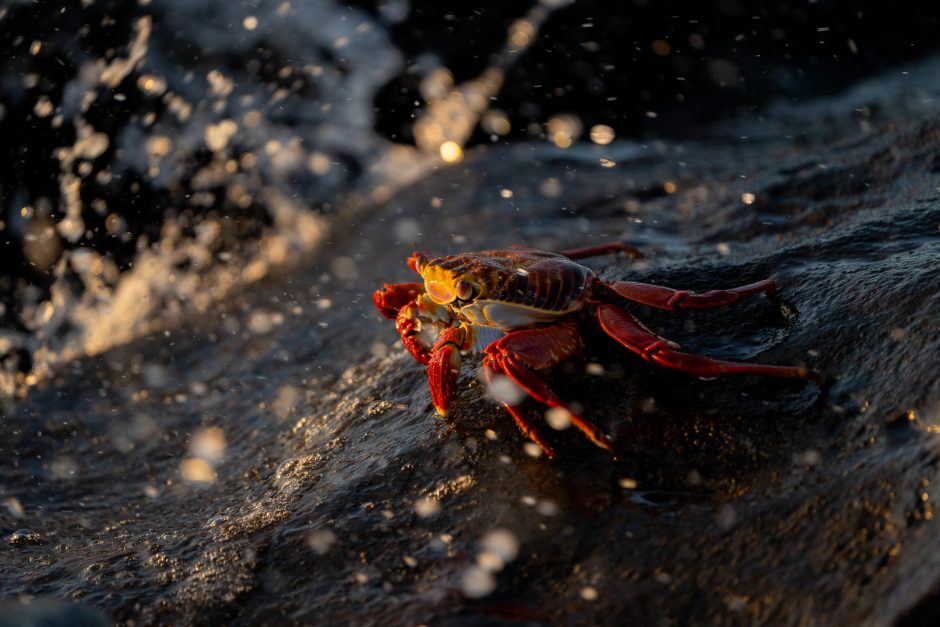
Shot Settings: Sally Lightfoot in the Sunset Surf
One of my photographic mantras is “Common is your classroom.” In the Galapagos, where Blue-footed Boobies dive-bomb from the sky and Galapagos Tortoises plow through the brush like ancient tanks, it’s easy to ignore the smaller stuff. Sometimes though, pushing your photographic boundaries with a “common” subject can give you the most striking images.
Take this Sally Lightfoot Crab; one of thousands crawling over the shoreline. The light was gold, the waves were loud, and the crab didn’t care that I was lying flat on wet lava rock, trying not to baptize my camera in saltwater. These crabs are pure visual candy; neon reds, yellows, and blues slapped across the world’s blackest rock. I wanted to make that color sing without losing the raw chaos of the surf. The trick was balancing light, motion, and sharpness before my subject decided to bail for deeper waters or another wave sent me scrambling.
Settings Breakdown
ISO 500
At sunset, you’re always negotiating with light. ISO 500 gave me enough juice to keep my shutter quick without introducing the gravelly noise of higher ISOs. Don’t fear a little grain though. It can feel gritty and honest or easily removed by editing software. Blurry subjects, on the other hand, are just bad photography pretending to be art.
Shutter Speed – 1/800 sec
It’s counterintuitive, but if you want to add energy and motion to an image, slow down your shutter speed. At 1/800 sec, I froze the crab but let the background water retain a bit of blur; a compromise between chaos and clarity. But don’t just settle on one number. Surf speed, wind, and wave distance all affect how much motion you’ll catch. Experiment. Take a handful of shots at different speeds, review them, and see what nails that feeling of movement without turning the whole frame into a white mess of spray.
Focal Length – 600mm
The Sony 200–600mm lens let me stay well back and still fill the frame. At that distance, compression works its magic, pulling the water closer and turning the background into abstract color and texture. It also saved me from an unexpected ocean bath; always a plus.
Aperture – f/6.3
At 600mm, even f/6.3 feels like threading a needle. The crab’s “face” is tack sharp while the surf melts into a painterly haze around it. Always, always focus on the eye. Miss that and no amount of editing wizardry will save you.
Take a lot of frames. Seriously. The surf never repeats itself, and those droplets that catch sunset light perfectly exist for about a quarter of a second. Shoot bursts and sort later. Digital film is cheap.
Fieldcraft
Fieldcraft is a fancy word for not spooking your subject or getting wrecked by the ocean. This crab wasn’t on the move. It had claimed its little lava outpost like a king on a throne. That’s my favorite kind of subject: predictable but still full of personality. My approach was simple. I crouched low, moved slow, and ensured the crab could ignore my presence.
I timed my bursts with the rhythm of the surf. Each wave hit, retreated, and reset for another aquatic assault on the shoreline. That’s the window. Start shooting right as the waves approach the rocks and the spray appears, creating ephemeral sunset jewels in the air. You’ll get soaked, yes, but that’s the cost of good fieldcraft. If you’re not at least a little salty and sunburned, you’re probably doing it wrong.
Final Thoughts
If you’re planning a trip to the Galápagos, add this image to your shot list. Photographing the Sally Lightfoot Crab is like trying to capture a living gemstone in a war zone. With ISO 500, f/6.3, and 1/800 sec, you can freeze its brilliance while letting the world around it roar. It’s part wildlife, part seascape, and part exercise in humility.
Want to try it for yourself? Join the Natural Habitat Adventures Galapagos Wildlife Photo Expedition, where the crabs are bold, the rocks are slippery, and every wave dares you to take one more shot before it hits.
Happy photographing,

Leave a reply